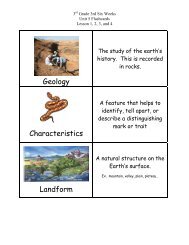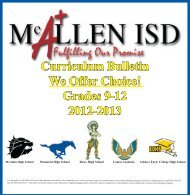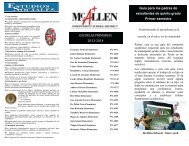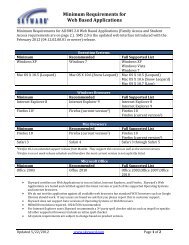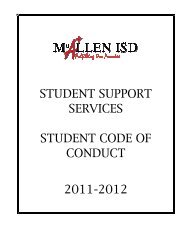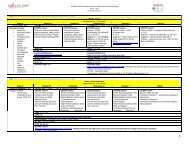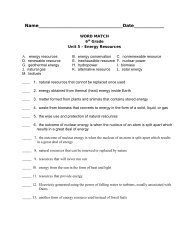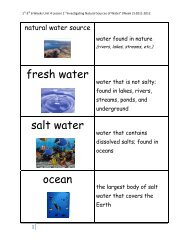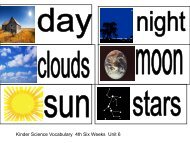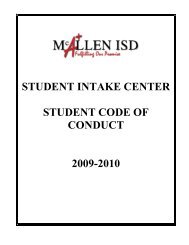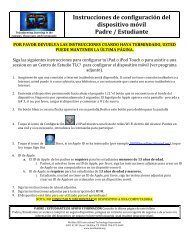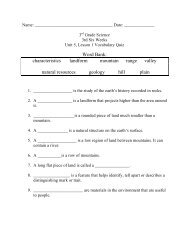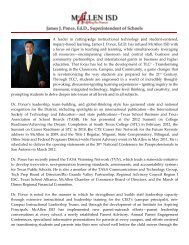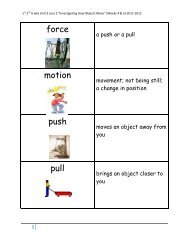3rd Grade Unit 01_IFD.pdf - McAllen ISD
3rd Grade Unit 01_IFD.pdf - McAllen ISD
3rd Grade Unit 01_IFD.pdf - McAllen ISD
You also want an ePaper? Increase the reach of your titles
YUMPU automatically turns print PDFs into web optimized ePapers that Google loves.
INSTRUCTIONAL FOCUS DOCUMENT<strong>Grade</strong> 3/ScienceUNIT: <strong>01</strong> TITLE: Investigating Properties of Matter SUGGESTED DURATION: 20 daysTEKS#SE# Scientific Process TEKS: Use appropriate Scientific processes to support instruction.3.2C Construct maps, graphic organizers, simple tables, charts, and bar graphs using tools and current technology to organize, examine, and evaluate measured data.3.2D Analyze and interpret patterns in data to construct reasonable explanations based on evidence from investigations.3.2E Demonstrate that repeated investigations may increase the reliability of results.3.2F Communicate valid conclusions supported by data in writing, by drawing pictures, and through verbal discussion.3.3 Scientific investigation and reasoning. The student knows that information, critical thinking, scientific problem solving, and the contributions of scientists are used inmaking decisions. The student is expected to:3.3A In all fields of science, analyze, evaluate, and critique scientific explanations by using empirical evidence, logical reasoning, and experimental and observational testing,including examining all sides of scientific evidence of those scientific explanations, so as to encourage critical thinking by the student.3.3B Draw inferences and evaluate accuracy of product claims found in advertisements and labels such as for toys and food.3.3C Represent the natural world using models such as volcanoes or Sun, Earth, and Moon system and identify their limitations, including size, properties, and materials.3.3D Connect grade-level appropriate science concepts with the history of science, science careers, and contributions of scientists.3.4 Scientific investigation and reasoning. The student knows how to use a variety of tools and methods to conduct science inquiry. The student is expected to:3.4A Collect, record, and analyze information using tools, including microscopes, cameras, computers, hand lenses, metric rulers, Celsius thermometers, wind vanes, raingauges, pan balances, graduated cylinders, beakers, spring scales, hot plates, meter sticks, compasses, magnets, collecting nets, notebooks, sound recorders, and Sun,Earth, and Moon system models; timing devices, including clocks and stopwatches; and materials to support observation of habitats of organisms such as terrariums andaquariums.3.4B Use safety equipment as appropriate, including safety goggles and gloves.The English Language Proficiency Standards (ELPS), as required by 19 Texas Administrative Code, Chapter 74, Subchapter A, §74.4, outline English language proficiencylevel descriptors and student expectations for English language learners (ELLs). School districts are required to implement ELPS as an integral part of each subject in therequired curriculum. School districts shall provide instruction in the knowledge and skills of the foundation and enrichment curriculum in a manner that is linguistically accommodated commensurate with the student’slevels of English language proficiency to ensure that the student learns the knowledge and skills in the required curriculum. School districts shall provide content-based instruction including the cross-curricular second language acquisition essential knowledge and skills in subsection (c) of the ELPS in a manner that islinguistically accommodated to help the student acquire English language proficiency.http://ritter.tea.state.tx.us/rules/tac/chapter074/ch074a.html#74.4ELPS#C(1)1C1EC(2)Subsection C: Cross-curricular second language acquisition essential knowledge and skills.Cross-curricular second language acquisition/learning strategies. The ELL uses language learning strategies to develop an awareness of his or her own learning processesin all content areas. In order for the ELL to meet grade-level learning expectations across the foundation and enrichment curriculum, all instruction delivered in English mustbe linguistically accommodated (communicated, sequenced, and scaffolded) commensurate with the student's level of English language proficiency. The student isexpected to:Use strategic learning techniques such as concept mapping, drawing, memorizing, comparing, contrasting, and reviewing to acquire basic and grade-level vocabulary.Internalize new basic and academic language by using and reusing it in meaningful ways in speaking and writing activities that build concept and language attainment.Cross-curricular second language acquisition/listening. The ELL listens to a variety of speakers including teachers, peers, and electronic media to gain an increasing level ofcomprehension of newly acquired language in all content areas. ELLs may be at the beginning, intermediate, advanced, or advanced high stage of English language©2<strong>01</strong>1, TESCCC 06/24/11 page 6 of 7



